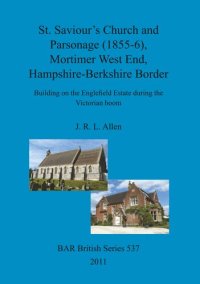
Ebook: St. Saviour's Church and Parsonage (1855-6), Mortimer West End, Hampshire-Berkshire Border: Building on the Englefield Estate during the Victorian boom
Author: J. R. L. Allen
- Series: BAR British Archaeological Reports British Series 537
- Year: 2011
- Publisher: BAR Publishing
- Language: English
- pdf
The Anglican church of St. Saviour’s and its former parsonage, in the historic Hampshire parish of Mortimer West End, lie on the northern shoulder of the valley of the eastward-draining West End Brook that dissects an extensive plateau underlain by the Pleistocene Silchester Gravel and the Bagshot and London Clay Formations (early Tertiary).The sponsor (and effectively the builder) was Richard Fellowes Benyon of Englefield House, Englefield in Berkshire, who had in 1854 inherited the Englefield Estate onthe death of his uncle. Designed by the London architect Richard Armstrong Snr, the church and parsonage were erected over a 20-month period in 1855-6, at a total cost of £3013, of which £473 represents various materials, goods and services provided directly by the Englefield Estate.There is seating for a mere 80 or so people, making it one of the most costly churches in the region. The church, lying outside its ‘geological zone’ of the Chalk Group, is a small building in the Gothic style, consisting of an aisleless nave, chancel, north porch and north vestry; another vestry was added in 1901-2 at the western end.Split flint faces the building externally and the dressings are of good quality Bathstone; internally the walls are plastered and painted, and there is wainscoting and a raftered wooden roof.The flooring is of wood and ceramic tiles (some in the chancel encaustic), with some Portland stone also in the chancel. Decoration is limited to carved heads on window hoodmould stops, the chancel arch and corbels.The window tracery, modeled on the Geometrical (early Decorated) style, but archaeologically incorrect, is very varied and represented by eight designs.The Parsonage and its offices are of red and blue-grey brick in Flemish bond with Bathstone dressings, and in the Picturesque style favoured by A.W.N. Pugin for houses and rectories.